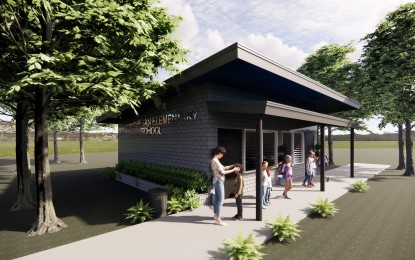
ECO-CLASSROOM. A prototype of a model eco-classroom being built in Caparispisan Elementary School in Pagudpud, Ilocos Norte. It will be made of eco-bricks with solar roofing. (Image courtesy of North Luzon Renewables)
LAOAG CITY— A model eco-classroom is being built in the coastal village of Caparispisan in Pagudpud, Ilocos Norte, where the wind blows the strongest for electricity generation.
Located at the Caparispisan Elementary School, the eco-classroom uses eco-bricks with shredded plastic waste materials as one of its components and the roofing will be installed with solar panels, said Raymond Sesuca, stakeholder management senior manager of North Luzon Renewables (NLR), which operates the country’s largest wind farm in Pagudpud.
“This is an NLR-initiated project as we are connecting it to our eco hub project in Piddig town,” Sesuca said in a phone interview Friday.
The eco hub Sesuca was referring to is a facility that converts plastic wastes into eco-bricks for construction projects.
Worth around PHP2 million, Sesuca said the first eco-friendly classroom built by the company as part of its corporate social responsibility program is expected to be completed by November this year.
To promote the use of eco-bricks for houses and buildings in the province, the NLR plans to build more eco-friendly and renewable classrooms to generate more jobs for local communities and to help preserve the environment.
In 2021, the Ayala-led renewable energy firm with Green Antz Builders established the eco-hub facility in Barangay Tonoton of Piddig to convert discarded plastic materials into eco-bricks claimed to be more durable than regular hollow blocks.
Since then, the facility has been collecting and reusing discarded plastic materials, transforming them into valuable resources.
One eco-brick may consist of 50 to 100 plastics and is five times stronger than a typical hollow block, according to Green Antz builders.
Despite an aggressive campaign against plastic pollution, some residents in the province still discard their plastic waste elsewhere or, worse, burn them in their backyards.
According to the World Business Council for Sustainable Development, the global demand for plastic continues to grow and is likely to double in the next 20 years.
However, only 9 percent of the total plastic produced is recycled hence, it is estimated that eight million tons of plastic leak into the environment.
Packaging is the largest application of plastics globally, creating a growing societal pressure for companies to adopt circular models with no waste. With appropriate technology, plastic products are broken down into pieces and mixed with cement and sand to produce eco-bricks.
While eco-bricks are more expensive per unit when compared to traditional bricks, these reduce the overall cost of building construction and operation.
They also allow for greater insulation, reducing energy consumption and resulting in lower electricity costs and environmental impact. (PNA)
